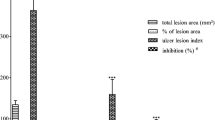Abstract
Lafoensia pacari A. St.-Hil., Lythraceae, is used in Brazilian folk medicine to treat ulcer and gastritis; thus, it is important to conduct research so as to better understand its medicinal properties. The aim of this study was to assess the antisecretory and antiulcerogenic activities of lyophilized aqueous fraction and punicalagin isolated from leaves of L. pacari. Antisecretory gastric acid activity and antiulcerogenic activity were investigated by pyloric ligation-induced and indomethacin-induced gastric lesion models, respectively. Results show that the lyophilized aqueous fraction of L. pacari and punicalagin reduced the volume of gastric secretion, free acidity, and total acidity in mice 4 h after pyloric ligation, as well as the rate of gastric damage following the indomethacin administration model. Reduction percentages varied according to the dose of each treatment and showed statistical difference. This finding indicates that the lyophilized aqueous fraction of L. pacari and punicalagin exert an antiulcerogenic effect due to their acid antisecretory activity.

Graphical Abstract
Similar content being viewed by others
References
Cabral PRF, Pasa MC (2009) Mangava-brava: Lafoensia pacari a. St. - Hil. (Lythraceae) and the ethnobotany of Cuiabá, MT. Rev Biodiversidade 8:2–21
Carneiro CC, Santos SC, Lino Junior RS, Bara MTF, Chaibub BA, Reis PRM, Chaves DA, Silva AJR, Silva LS, Silva DM, Chen-Chen L (2016) Chemopreventive effect and angiogenic activity of punicalagin isolated from leaves of Lafoensia pacari A. St.-Hil. Toxicol Appl Pharmacol 310:1–8
Djahanguiri B (1969) The production of aacute gastric ulceration by indomethacin in the rat. Scand J Gastroenterol 4:265–267
Galdino PM, Nascimento MVM, Sousa FB, Ferreira RN, Paula JR, Costa EA (2010) Central activities of hydroalcoholic extract from Lafoensia pacari a. St.-Hil. stem bark. Braz J Pharm Sci 46:455–462
Guimarães H, Nascimento MVM, Tavares A, Galdino PM, Paula JR, Costa EA (2010) Effects of ethanolic extract of leaves of Lafoensia pacari A. St.-Hil., Lythraceae (pacari), in pain and inflammation models. Rev Bras Farmacogn 20:328–333
Jesus NZT, Lima JCS, Silva RM, Espinosa MM, Martins DTO (2009) Ethnobotanical survey of plants popularly used as anti-ulcer and anti-inflammatory in Pirizal, Nossa Senhora do Livramento, MT, Brazil. Rev Bras Farmacogn 19:130–139
Martins JLR, Rodrigues ORL, Fajemiroye JO, Galdino PM, Florentino IF, Costa EA (2015) Medicinal species with gastroprotective activity found in the Brazilian Cerrado. Fundam Clin Pharmacol 29:238–251
Martins JLR, Sousa FB, Fajemiroye JO, Ghedini PC, Ferreira PM, Costa EA (2014) Anti-ulcerogenic and antisecretory effects of Celtis iguanaea (Jacq) Sargent hexane leaf extract. Rev Bras Farmacogn Pl Med 16:250–255
Muthuraman A, Soo S (2010) Antisecretory, antioxidative and antiapoptotic effects of montelukast on pyloric ligation and water immersion stress induced peptic ulcer in rat. Prostaglandins Leukot Essent Fat Acids 83:55–60
Nascimento MVM, Galdino PM, Florentino IF, Sampaio BL, Vanderlinde FA, Paula JR, Costa EA (2011) Antinociceptive effect of Lafoensia pacari A St-Hil independent of anti-inflammatory activity of ellagic acid. J Nat Med 65:448–454
Sampaio BL, Bara MTF, Ferri PH, Santos SC, Paula JR (2011) Influence of environmental factors on the concentration of phenolic compounds in leaves of Lafoensia pacari. Rev Bras Farmacogn 21:1127–1137
Silva TC, Zara ALSA, Sá FAS, Bara MTF, Avila RI, Costa CR, Valadares MC, Santos AS, Freitas VAQ, Silva MRR (2018) Antifungal potential of punicalagin against Cryptococcus neoformans species complex. Rev Inst Med Trop São Paulo 60:1–6
Tamashiro Filho P, Olaitan BS, Almeida DAT, Lima JCS, Marson-Ascêncio PG, Ascêncio SD, Rios-Santos F, Martins DTO (2012) Evaluation of antiulcer activity and mechanism of action of methanol stem bark extract of Lafoensia pacari A. St.-Hil. (Lythraceae) in experimental animals. J Ethnopharmacol 144:497–505
Visscher FE, Seay PH, Tazelaar Junior AP, Veldkamp W, Vander Brook MJ (1954) Pharmacology of pamine bromide. J Pharmacol Exp Ther 110:188–204
Funding
The authors are grateful to Capes and CNPQ for the financial support provided.
Author information
Authors and Affiliations
Contributions
BAC: acquisition, analysis, and interpretation of data. JLRM: acquisition of pharmacological data and statistical expertise. EAC: design of pharmacological tests and provision of materials. SCS: isolation of punicalagin. JRP: provision of materials. MTFB: study design, provision of materials, securing of funding, and writing of article.
Corresponding author
Ethics declarations
Conflict of Interest
The authors declare that they have no conflicts of interest.
Rights and permissions
About this article
Cite this article
Chaibub, B.A., Martins, J.L.R., de Paula, J.R. et al. Gastroprotective activity of punicalagin and Lafoensia pacari in mice. Rev. Bras. Farmacogn. 30, 423–426 (2020). https://doi.org/10.1007/s43450-020-00007-7
Received:
Accepted:
Published:
Issue Date:
DOI: https://doi.org/10.1007/s43450-020-00007-7




